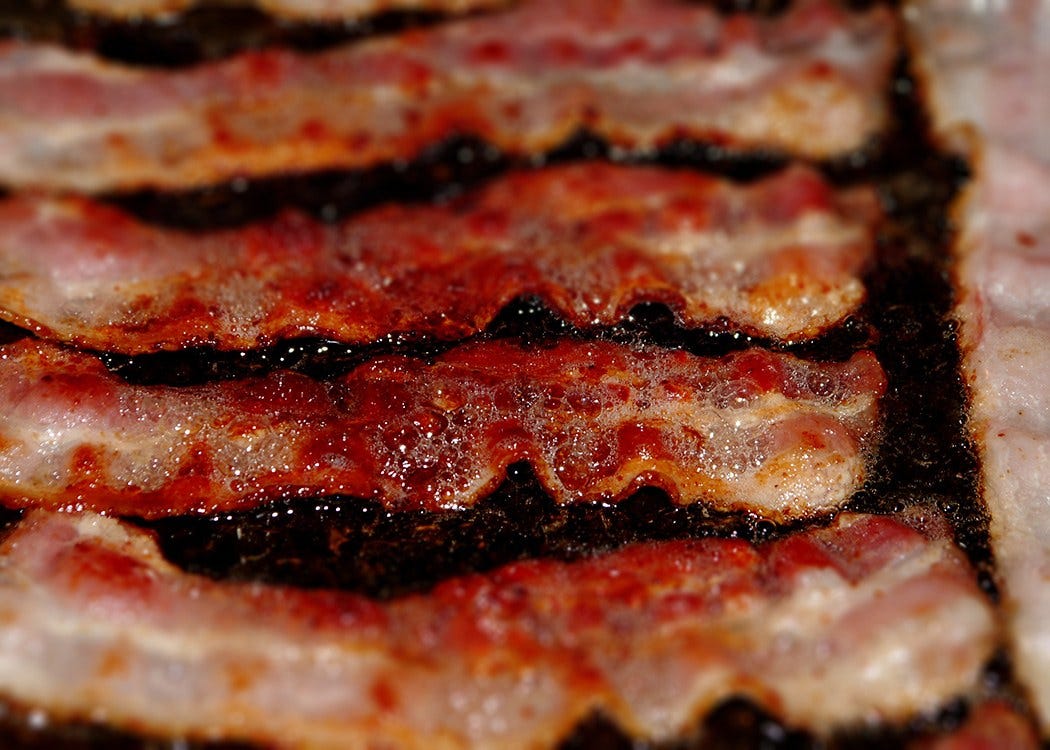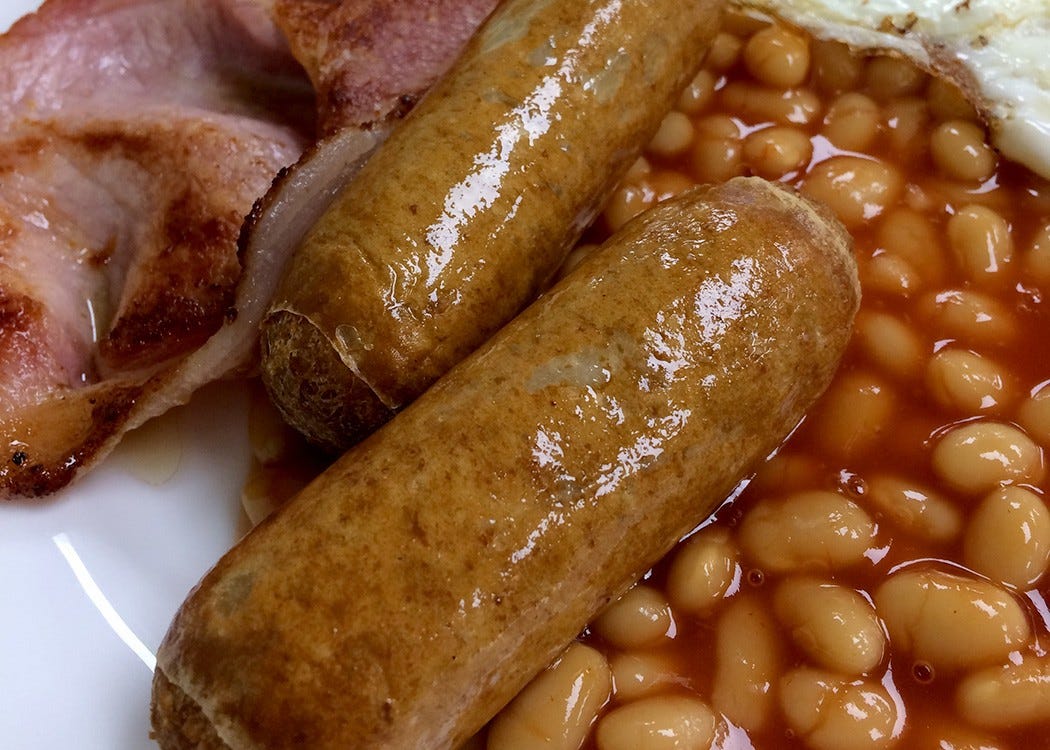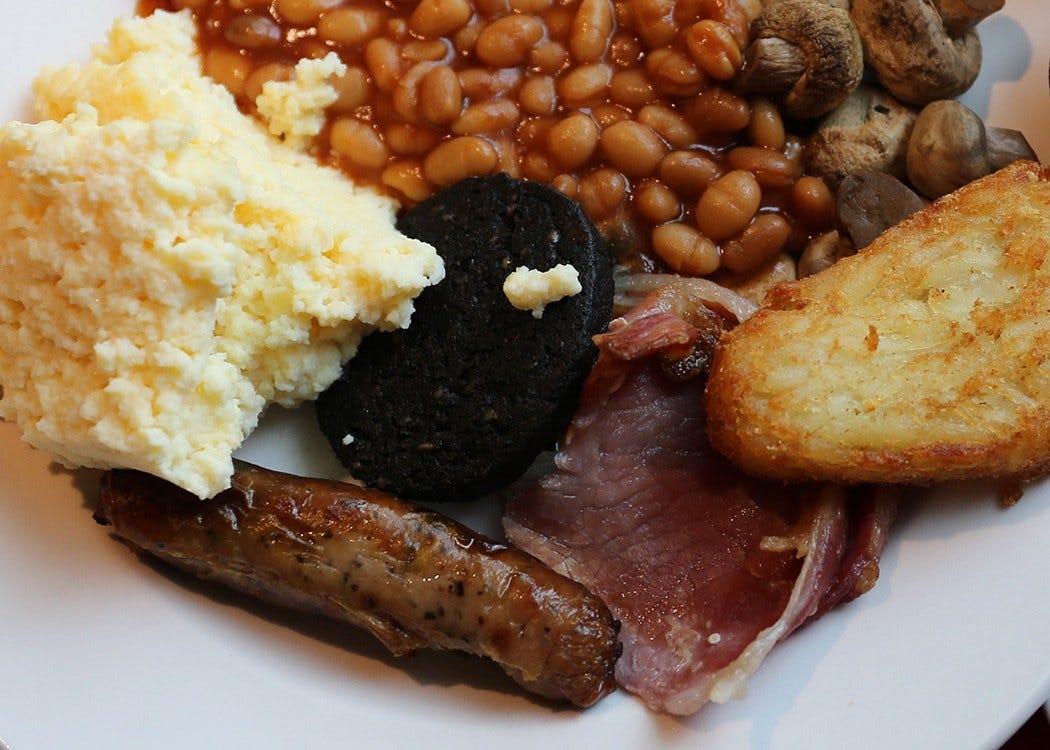Bacon and Sausages - a match made in heaven
Categories:
There are few smells and sounds, more evocative than bacon sizzling away in a frying pan. For me it brings back happy memories of long summer holidays in the family caravan. That first crackle and splutter, shortly followed by the unmistakable aroma of salty loveliness, would make my stomach rumble in anticipation of the hearty breakfast that would set me up for a day of rock pooling, sandcastle building and kite flying. If we were lucky, sausages would be added to the mix, but this usually meant a long walk was planned as the activity for the day, so for a young boy this was always a mixed blessing!
Fast forward a couple of decades and the ‘full English’ would become a much needed comfort medicine after a heavy night out. It’s greasy consistency slipping down the throat and soaking up any excesses from the night before, settling the stomach and making you feel almost human once more, whilst muttering the words ‘never again’.
Today having sausages and bacon for breakfast is a once-in-a-while Sunday morning treat with my family. Now, half the enjoyment is perfecting that perfectly cooked rasher of bacon and cooking a sausage that has a crispy skin on the outside, yet is deliciously moist on the inside. There are many schools of thought on the best way to cook these meaty morsels, and while we may not have the definitive answer, we do have a huge range of products that will inspire your quest for the perfect rasher and snorker.

Don't go bacon my heart
Undeniably tasty as bacon is, the first question you need to ask yourself is which cut to go for. Whether it is an essential component of your ‘full English’ or piled high between two slices of bread, there’s a perfect cut of meat out there waiting to be discovered. The most common cuts to look out for include Back, Middle and Streaky. Back bacon, as the name implies is taken from the back of the pig behind the collar. Sliced thinly, these rashers are delicious grilled, baked or fried. Middle rashers are taken from further down the back of the pig. Perfect for fried breakfasts they are also an economical cut. Streaky bacon is taken from below the back bacon and behind the shoulder of the pig. Another economical cut, streaky bacon provides a tasty combination of fat and lean meat which is best grilled.
There are three main methods of cooking bacon - frying, grilling and baking. It’s really worth taking some time to experiment with these to see which gives you the best results for the cut of bacon you are using.
Frying
Make sure your rashers are at room temperature as this softens the fat in the bacon. For the best results, add your bacon to a cold frying pan. Lay the rashers flat and make sure they don’t overlap, otherwise they won’t cook evenly. Turn on the heat to a low setting and as the bacon begins to heat up some of the fat will start to render down helping the rashers to cook evenly. If there’s too much fat collecting in the frying pan carefully drain some away onto some kitchen towel. After a few minutes the bacon will start to bubble and curl. At this point you can turn the rasher using a spatula or silicone tongs. Don’t be tempted to use a fork to stab and flip the rasher as this could damage the surface of your pan. Cook for a few more minutes until the bacon is to your liking - the longer you leave it the crispier it will get. Remove the rashers from the pan and allow them to drain on some kitchen paper before serving.
The Kit - Invest in a good quality non-stick frying pan (sometimes referred to as a skillet), the larger the better. A heavy base will ensure even heat distribution. Hard anodised frying pans are tough and durable with superior heat distribution. Stainless steel is probably the most popular materials used for frying pans. Not a great distributor of heat on its own, stainless steel usually has an aluminium core to ensure fast and even heat distribution across the pan. A good non-stick surface will prevent your bacon from sticking while cooking.
Grilling
Very similar in principle to frying. The main difference when grilling is that the grill pan is preheated before adding the bacon. The ridged base drains away excess fat from the bacon, making it a slightly healthier cooking method, and allowing it to crisp up nicely. Remember to flip the bacon rashers halfway through cooking.
The Kit - A grill pan has ridges on the cooking surface which help to drain fat away from the bacon during frying, making it a slightly healthier cooking method. It also allows the bacon to crisp up more as it cooks. There are also some great electric grills available as well as the novel Bacon Toaster from Smart (one of our favourites in the office).
Baking
This method of cooking bacon doesn’t come naturally to me, but having tried it I must admit it works well. Place the bacon rashers onto a solid baking sheet and place in a cold oven. Turn on the heat to around 205°C and cook for 20 minutes or so, turning the bacon over halfway through. To cut down on your washing up you can always line the baking sheet with kitchen foil. Something I’ve not yet tried is adding a wire rack to this process. Similar to grilling, the wire rack lets excess fat drain away from the bacon. It also allows the warm air of the oven to circulate around the rashers for even cooking and crispier results.
The Kit - A hard anodised Baking Tray is a good option if your are using the baking method. Made from aluminium, it’s a great conductor and distributor of heat and has a durable surface which is abrasion resistant and metal utensil safe. A ceramic roaster is another popular alternative.

A corker of a snorker
Bangers, links, snags, snorkers… whatever you call them, sausages are a popular staple of our diet. The word sausage derives from the Latin salsicus, meaning seasoned with salt. This was adapted by the Old North French to saussiche which in turn was translated into English as sawsyge in the mid-15th century. Originally a method of preserving leftover scraps of meat and fat with salt and encasing it in the cleaned animal’s intestines, it is one of the oldest types of prepared food. Today there are hundreds of different styles of sausage that have evolved in different regions across the globe.
Although there are so many varieties available, the core ingredients of a good sausage are meat, fat, rusk (or breadcrumbs), water and seasoning. Don’t think that a 100% meat only sausage would be a better tasting sausage. The rusk absorbs some of the fat, adding flavour and giving the sausage texture. It also prevents the sausage from shrinking when it is being cooked. The fat allows the sausage to cook evenly whilst water keeps the rusk hydrated, so everything stays nice and juicy. Incidentally, the name banger came about during the Second World War when meat was rationed and extra water was added, causing the sausages to burst as they cooked. Salt imparts flavour and helps keep the meat succulent and tender. All of these ingredients are encased in a skin or casing which can either be natural or artificial.
As with bacon, there are many ways of cooking sausages, but whichever method you prefer - use the mantra ‘low and slow’ and you won’t go wrong. Sausages need to be thoroughly cooked all the way through, so if you have too high a heat source you’ll end up with a burnt skin and the risk of uncooked meat in the centre.
Never be tempted to prick a sausage to release the fat. Even the cheapest of sausages is unlikely to contain enough water for them to go bang and all you are doing is removing flavour and natural juices. This fat will render down helping to cook the sausage evenly and preventing it from drying out.
Try frying sausages low and slow in a frying pan with a little oil or butter for the best flavour, turning them occasionally so they brown evenly. Try grilling them as a healthier option, again using the low and slow mantra. Grilling will give a crispier skin to your sausage. There are some great electric grill options available.
Oven cooking is another option worth pursuing. Cooking them in a baking pan is the simplest method as you don’t need to keep turning the sausages as they cook. The only downside is you won’t get the characteristic grill marks you get when frying or grilling.

Make your own sausages
I must admit I would rather go in search of an artisan sausage than go through the rigmarole of making your own, but it’s easier than you think and you’ll know exactly what goes into them! All you need is a good quality mincer and a sausage stuffer to fill your casings with the sausage mixture.
The only question that needs answering now is what constitutes a full English? Should the eggs be fried or scrambled? Toast or fried bread? Baked beans and hash browns - yes or no? On second thoughts, that’s a lot of questions. Best I go back to reminiscing about childhood holidays. Now, where did I put my bucket and spade?




